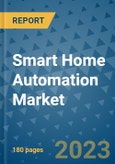This comprehensive analysis delves into the dynamic global smart home automation market, shedding light on its current state, growth drivers, and future prospects.
The smart home automation market's evolution is driven by technological advancements, rising consumer interest in smart devices, and the benefits of automation across various sectors. Despite challenges, the market is set for substantial growth as innovative solutions continue to shape the way we interact with our homes.
This product will be delivered within 1-3 business days.
Market Size and Growth
The smart home automation market, which was valued at USD 89.4 billion in 2021, is projected to grow at an impressive CAGR of 14.1 percent during the forecast period. The market is poised to benefit from increasing millennial homeownership rates and the widespread adoption of Internet of Things (IoT) technology. Rising disposable income in developing countries is expected to drive the demand for smart home automation systems, with technology integration such as IoT, AI, and ML further contributing to market expansion. A survey by Voicbot.ai revealed that around 87.7 million US consumers were using smart speakers by January 2020, highlighting the growing inclination towards smart home automation technology.Pandemic Impact and Recovery
The COVID-19 pandemic had a negative impact on the smart home automation market, disrupting production and supply chains due to lockdowns and reduced labor availability. However, the increased stay-at-home measures led to a surge in demand for smart devices such as smart TVs, streaming sticks, and smart appliances. As restrictions ease, the market is on track for recovery, with the convenience and efficiency offered by smart devices continuing to attract consumers.Driving Factors
The market's growth is driven by the automation sector's flexibility and high precision management, particularly in security systems. Investment in advanced smart security systems to address increasing security demands contributes to the market's expansion. Additionally, rising interest in smart home technology, particularly among millennials, is propelling the adoption of smart devices and automation solutions. The concept of the kitchen has undergone transformation due to IoT and smart appliances, driving the demand for smart kitchen solutions.Challenges and Restraints
The high cost of automation equipment limits access for those with lower disposable income. Complex technology and limited user familiarity also hinder the adoption of smart home automation devices. These factors present challenges to market growth.Segment Analysis
Among product segments, wireless technology leads the market due to its flexibility, customization capabilities, and support for multiple devices. The smart kitchen segment dominates the application category, benefiting from the increasing demand for smart appliances and IoT technology.Regional Landscape
North America holds the largest revenue share, fueled by established manufacturers, a robust consumer base, and high technology acceptance rates. The Asia Pacific region is also experiencing steady revenue growth, driven by investments in smart technologies and rising disposable income. China, India, and countries in the Asia Pacific are significant contributors to the market's expansion.Competitive Landscape
Key players shaping the market include ABB Ltd., Control4 Corporation, Crestron Electronics, Honeywell International Inc., Ingersoll-Rand plc, Johnson Controls, Legrand SA, Leviton Manufacturing Company, Lutron Electronics Co., Schneider Electric, and Siemens AG. Technological advancements and collaborative efforts like the Project Connected Home over IP by Apple, Google, Amazon, and Zigbee Alliance, are shaping the competitive landscape.The smart home automation market's evolution is driven by technological advancements, rising consumer interest in smart devices, and the benefits of automation across various sectors. Despite challenges, the market is set for substantial growth as innovative solutions continue to shape the way we interact with our homes.
This product will be delivered within 1-3 business days.
Table of Contents
1. Executive Summary
2. Market Overview
3. Global Smart Home Automation Market Outlook, 2018 - 2030
4. North America Smart Home Automation Market Outlook, 2018 - 2030
5. Europe Smart Home Automation Market Outlook, 2018 - 2030
6. Asia Pacific Smart Home Automation Market Outlook, 2018 - 2030
7. Latin America Smart Home Automation Market Outlook, 2018 - 2030
8. Middle East & Africa Smart Home Automation Market Outlook, 2018 - 2030
9. Competitive Landscape
10. Appendix
Companies Mentioned
- Google Inc.
- Honeywell International Inc.
- ABB Ltd.
- AMX
- Johnson Controls
- Legrand SA
- Siemens AG
- Schneider Electric
- Ingersoll-Rand plc
- Savant Systems Inc.
- Philips
- Crestron
- Control4
Methodology

LOADING...



![Smart Home Market: Trends, Opportunities and Competitive Analysis [2024-2030] - Product Image](http://www.researchandmarkets.com/product_images/12658/12658618_60px_jpg/smart_home_market.jpg)




